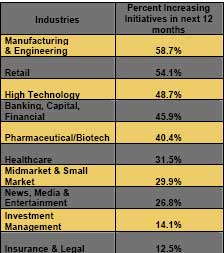To date, PO adoption has remained primarily within the realm of indirect materials, not so called “direct materials” such as those that go into manufacturing processes or involve finished goods that are resold. Still, Procurement Outsourcing is targeted at four primary areas, one of which can involve direct materials:
- Total Spend Management
- Sourcing and Supply Chain/Logistics (Procure-to-Pay)
- Category Management
- Transaction Processing (Transactional Requisition-to-Pay processes)
There are many drivers for adoption, but one of them is certainly the potential to leverage world class technology systems without the need for the outsourcing company to invest and support those systems directly.
“One of the important payoffs realized by PO adopters is the opportunity of utilization of top-notch procurement systems and processes without making huge capital investments,” the report states. “Procurement outsourcing as a strategy works well for companies who constantly battle with the nonconformist buying issues despite having made considerably large investments in strategic sourcing and e-procurement in the form of time and money.”
What are Customers Looking for in a Procurement Outsourcing Solution?
Wilson and Brown surveyed over 3000 companies on PO, and identified the top 10 capabilities and benefits they were searching for in an outsourced procurement solution, as shown in the table below.
What PO Buyers are Seeking in Vendors |
Most Attractive PO Characteristics
|
Percent Listing Capability in Top 3 Requirements |
Arsenal of Sourcing Strategies & Solutions |
95.1% |
Savings Implementation |
90.2%
|
Improved Supplier Compliance |
80.4% |
Vertical Expertise |
75.8% |
Purchase-to-Pay Transaction Expertise |
75.5%
|
Project-Based Solutions |
72.7% |
Sourcing Database & Analytics |
64.2% |
Spend Analysis |
38.6% |
Technological Procurement Innovation |
37.2% |
Supplier Performance Reporting |
33.9% |
Breadth of Category Experience |
13.2% |
Comprehensive/End-to-End Capabilities |
10.4 |
Post Merger & Acquisition Synergies |
9.6% |
Source: Black Book of Procurement Outsourcing |
“One of the more recent drivers shifting procurement outsourcing into the spotlight is procurement's unique ability to generate value as well as reduce costs – something companies desperately need in the current economic environment,” the report notes. “Procurement outsourcing provides reductions in operational costs, but procurement's ability to impact third-party expenditures, in addition to operational expenses, delivers immediate results to the bottom line. A dollar saved is a dollar earned, and companies can use these dollars in several ways: They can earmark the immediate savings to self-fund the procurement initiative or use the new cash stream to fund other strategic initiatives. This value creation factor makes procurement outsourcing a compelling story.”
In other words, companies believe Procurement Outsourcing not only can reduce or improve human capital efficiency in purchasing, but also the actual costs of goods purchased as well.
Industry Differences
Different vertical industries are adopting procurement outsourcing at different rates, the authors note.
The table below shows the expected plans for increasing PO by industry type:

The authors predict substantial market growth. “Procurement Outsourcing is among the fastest growing Business Process Outsourcing areas,” they note. “We expect the worldwide market for PO to increase to $6.0 billion in 2008, projecting a 37% CAGR (compounded annual growth rate).”
Do you agree Procurement Outsourcing is growing rapidly? How is it best used? What are the pitfalls? Let us know your thoughts at the Feedback button below.
Do you agree or disagree? Share your perspective by emailing us at feedback@scdigest.com |